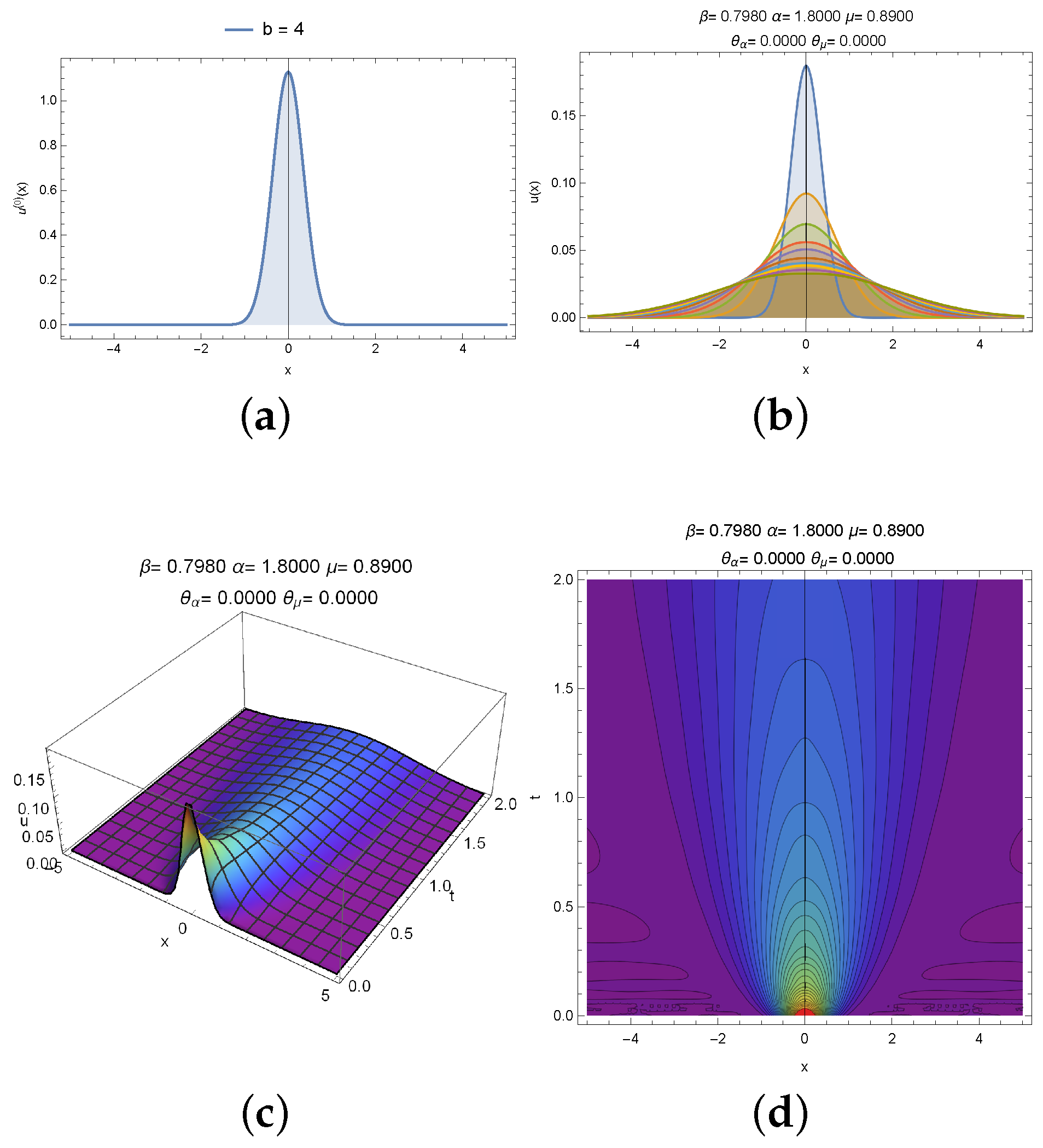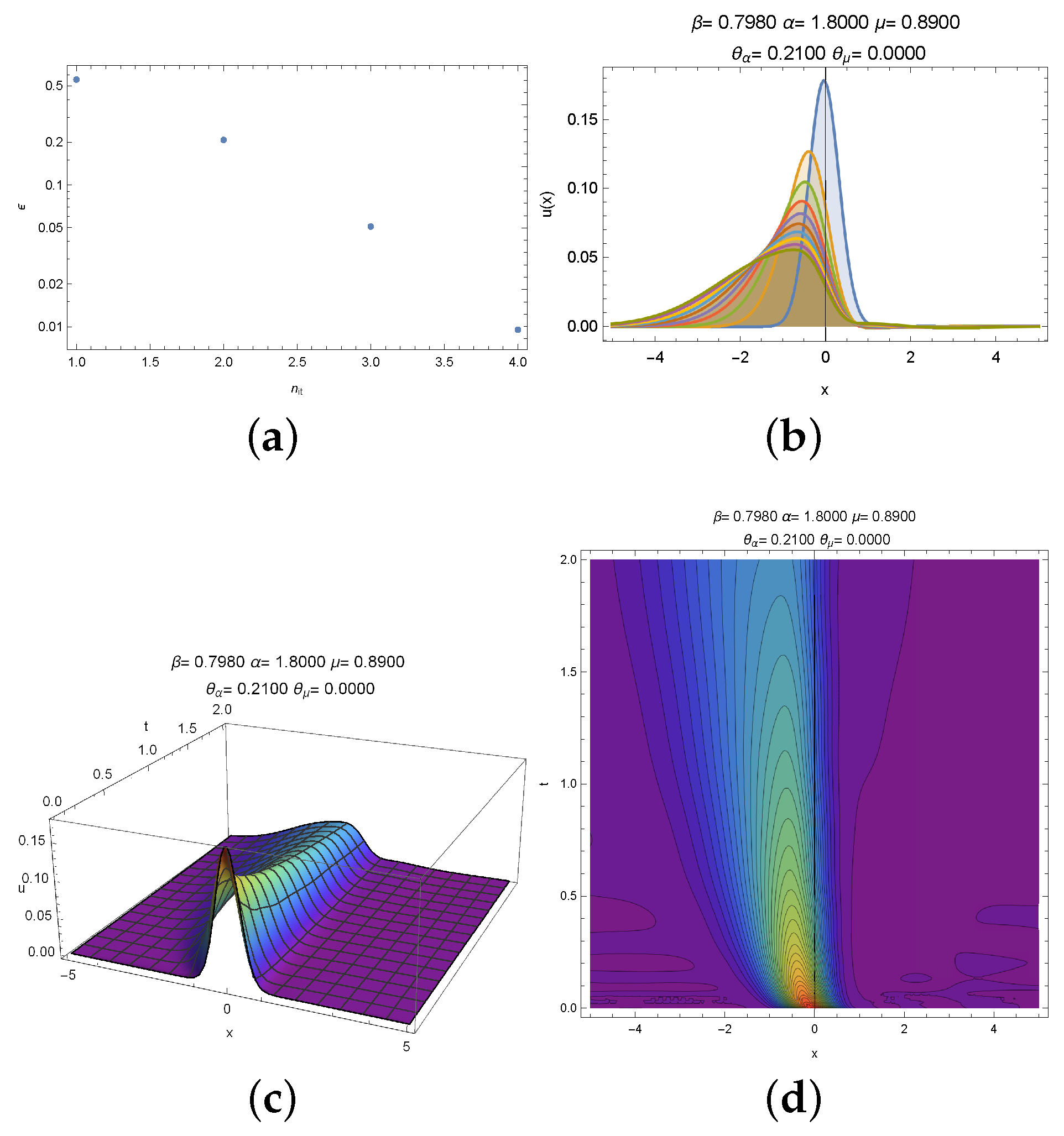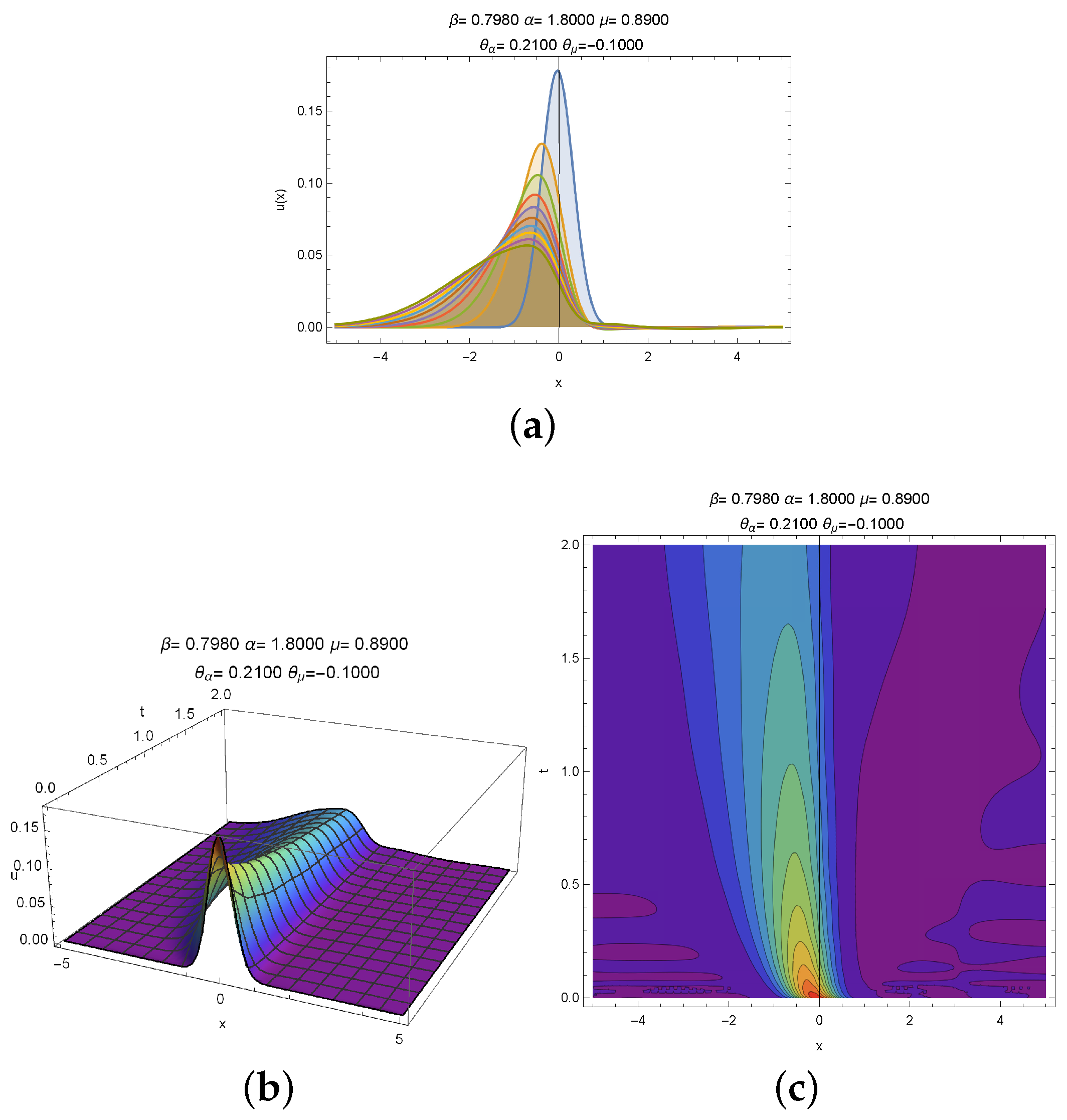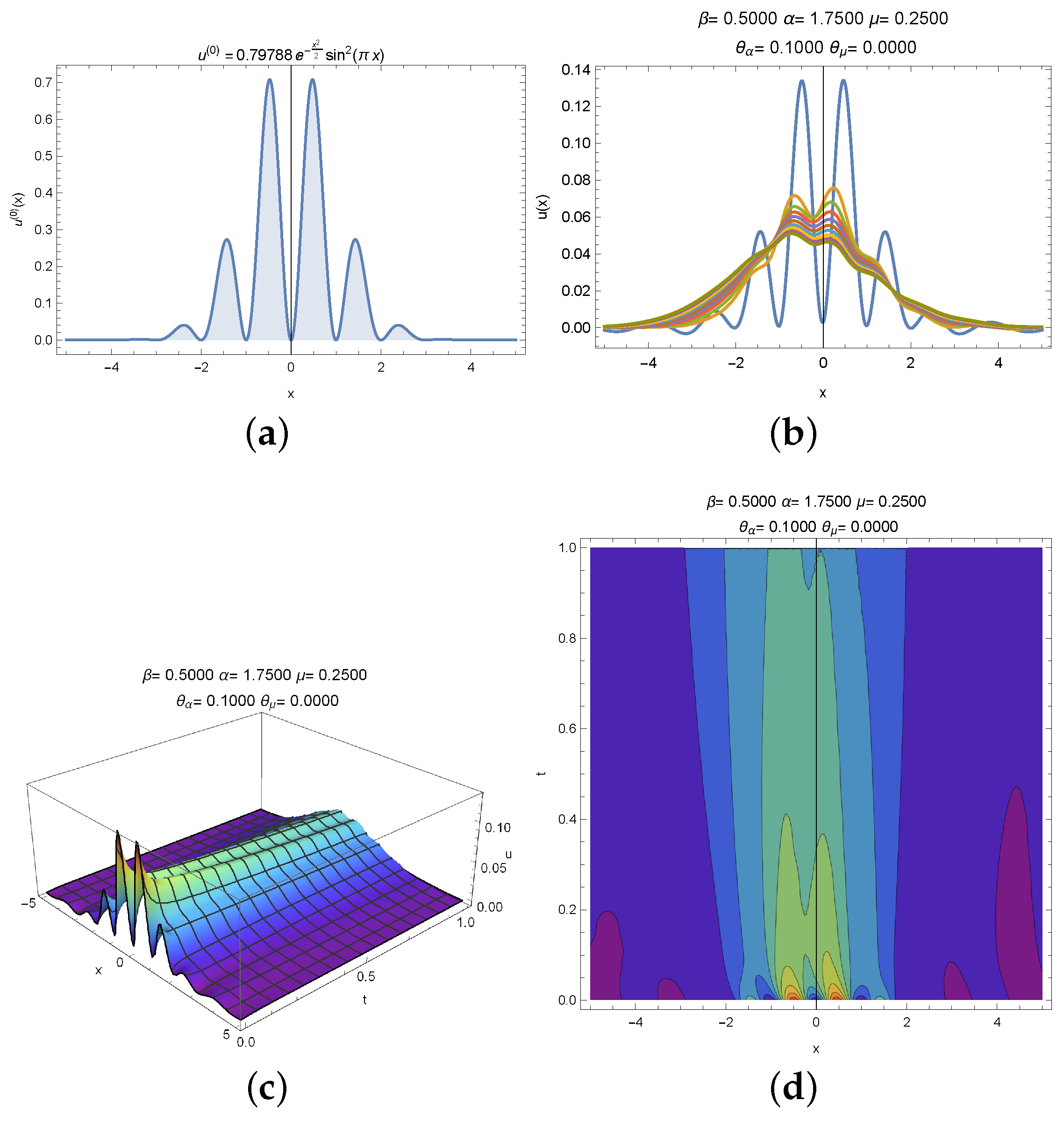Fractional Fokker-Planck Equation †
Abstract
:1. Introduction
2. Methods of Approximation
2.1. Sinc Basis
2.2. Indefinite Integral
2.3. Convolution Integrals
2.4. Convolution Integrals in Two Variables
2.5. Sinc Collocation of fFP
3. Experimental Section
4. Conclusions
Acknowledgments
Author Contributions
Conflicts of Interest
Appendix A
References
- Risken, H. The Fokker-Planck Equation. Methods of Solution and Applications; Springer: Berlin, Germany; New York, NY, USA, 1989. [Google Scholar]
- Gorenflo, R.; Mainardi, F.; Moretti, D.; Pagnini, G.; Paradisi, P. Discrete random walk models for space-time fractional diffusion. Strange Kinetics 2002, 284, 521–541. [Google Scholar] [CrossRef]
- Scales, E.; Gorenflo, R.; Mainardi, F.; Raberto, M. Revising the Derivation of the Fractional Diffusion Equation. In Scaling and Disordered Systems; Family, F., Daoud, M., Hermann, H., Stanley, H.E., Eds.; World Scientific Publishing Co., Pte. Ltd.: Singapore, 2002; pp. 281–289. [Google Scholar]
- Scalas, E.; Gorenflo, R.; Mainardi, F. Fractional calculus and continuous-time finance. Physica A 2000, 284, 376–384. [Google Scholar] [CrossRef]
- Mainardi, F.; Rabertob, M.; Gorenflo, R.; Scalas, E. Fractional calculus and continuous—Time finance II: The waiting-time distribution. Physica A 2000, 287, 468–481. [Google Scholar] [CrossRef]
- Stenger, F.; Tucker, D.; Baumann, G. Navier-Stokes Equation on ℝ3 × [0,T]; Springer International Publishing: Cham, Switzerland, 2016. [Google Scholar]
- Stenger, F.; Baumann, G.; Koures, V.G. Computational Methods for Chemistry and Physics, and Schrödinger in 3 + 1. In Concepts of Mathematical Physics in Chemistry: A Tribute to Frank E. Harris—Part A; Elsevier: Amsterdam, The Netherlands, 2015; Volume 71, pp. 265–298. [Google Scholar]
- Dolgov, S.V.; Khoromskij, B.N.; Oseledets, I. Fast solution of multi-dimensional parabolic problems in the TT/QTT formats with initial application to the Fokker-Planck equation. SIAM J. Sci. Comput. 2012, 34, A3016–A3038. [Google Scholar] [CrossRef]
- Dolgov, S.; Khoromskij, B.N. Simultaneous state-time approximation of the chemical master equation using tensor product formats. Numer. Linear Algebra Appl. 2015, 22, 197–219. [Google Scholar] [CrossRef]
- Chen, W.; Wang, F. Singular boundary method using time-dependent fundamental solution for transient diffusion problems. Eng. Anal. Bound. Elem. 2016, 68, 115–123. [Google Scholar] [CrossRef]
- Wang, F.; Chen, W. Accurate empirical formulas for the evaluation of origin intensity factor in singular boundary method using time-dependent diffusion fundamental solution. Int. J. Heat Mass Transf. 2016, 103, 360–369. [Google Scholar] [CrossRef]
- Jeon, J.-H.; Metzler, R. Fractional Brownian motion and motion governed by the fractional Langevin equation in confined geometries. Phys. Rev. E 2010, 81, 021103. [Google Scholar] [CrossRef] [PubMed]
- Metzler, R.; Klafter, J. The Random Walks Guide to Anomalous Diffusion: A Fractional Dynamics Approach. Phys. Rep. 2000, 339, 1–77. [Google Scholar] [CrossRef]
- Chechkin, A.V.; Zaid, I.M.; Lomholt, M.A.; Sokolov, I.M.; Metzler, R. Bulk-mediated surface diffusion along a cylinder: Propagators and crossovers. Phys. Rev. E 2009, 79, 040105. [Google Scholar] [CrossRef] [PubMed]
- Gorenflo, R.; Mainardi, F. Some recent advances in theory and simulation of fractional diffusion processes. J. Comput. Appl. Math. 2009, 229, 400–415. [Google Scholar] [CrossRef]
- Baumann, G.; Stenger, F. Sinc-Approximations of Fractional Operators: A Computing Approach. Mathematics 2015, 3, 444–480. [Google Scholar] [CrossRef]
- Baumann, G.; Stenger, F. Fractional calculus and Sinc methods. Fract. Calc. Appl. Anal. 2011, 14, 568–622. [Google Scholar] [CrossRef]
- Stenger, F. Handbook of Sinc Numerical Methods; CRC Press: Boca Raton, FL, USA, 2011. [Google Scholar]
- Stenger, F. Summary of Sinc numerical methods. J. Comp. Appl. Math. 2000, 121, 379–420. [Google Scholar] [CrossRef]
- Stenger, F. Collocating convolutions. Math. Comp. 1995, 64, 211–235. [Google Scholar] [CrossRef]
- Stenger, F. Numerical Methods Based on Sinc and Analytic Functions; Springer: New York, NY, USA, 1993. [Google Scholar]
- Kowalski, M.A.; Sikorski, K.A.; Stenger, F. Selected Topics in Approximation and Computation; Oxford University Press: New York, NY, USA, 1995. [Google Scholar]
- Stenger, F.; El-Sharkawy, H.A.M.; Baumann, G. The Lebesgue Constant for Sinc Approximations. In New Perspectives on Approximation and Sampling Theory—Festschrift in the Honor of Paul Butzer’s 85th Birthday; Zayed, A., Schmeisser, G., Eds.; Birkhaeuser: Basel, Switzerland, 2014; pp. 319–335. [Google Scholar]
- Youssef, M.; El-Sharkawy, H.A.; Baumann, G. Lebesgue Constant Using Sinc Points. Adv. Numer. Anal. 2016. [Google Scholar] [CrossRef]
- Youssef, M.; El-Sharkawy, H.A.; Baumann, G. Multivariate Lagrange Interpolation at Sinc Points Error Estimation and Lebesgue Constant. J. Math. Res. 2016, 8, 118. [Google Scholar] [CrossRef]
- Youssef, M.R.; Baumann, G. Collocation Method to Solve Elliptic Equations, Bivariate Poly-Sinc Approximation. J. Progress. Res. Math. 2016, 7, 1079–1091. [Google Scholar]
- Lubich, C. Convolution Quadrature and Discretized Operational Calculus. I. Numer. Math. 1988, 52, 129–145. [Google Scholar] [CrossRef]
- Lubich, C. Convolution Quadrature and Discretized Operational Calculus. II. Numer. Math. 1988, 52, 413–425. [Google Scholar] [CrossRef]
- Han, L.; Xu, J. Proof of Stenger’s conjecture on matrix I(-1) of Sinc methods. J. Comput. Appl. Math. 2014, 255, 805–811. [Google Scholar] [CrossRef]
- Paradisi, P.; Cesari, R.; Mainardi, F.; Maurizi, A.; Tampieri, F. A generalized Fick’s law to describe non-local transport effects. Phys. Chem. Earth Part B Hydrol. Oceans Atmos. 2001, 26, 275–279. [Google Scholar] [CrossRef]
- Kilbas, A.A.; Srivastava, H.M.; Trujillo, J.J. Theory and Applications of Fractional Differential Equations; Elsevier: Amsterdam, The Netherlands, 2006. [Google Scholar]





© 2017 by the authors. Licensee MDPI, Basel, Switzerland. This article is an open access article distributed under the terms and conditions of the Creative Commons Attribution (CC BY) license ( http://creativecommons.org/licenses/by/4.0/).
Share and Cite
Baumann, G.; Stenger, F. Fractional Fokker-Planck Equation. Mathematics 2017, 5, 12. https://doi.org/10.3390/math5010012
Baumann G, Stenger F. Fractional Fokker-Planck Equation. Mathematics. 2017; 5(1):12. https://doi.org/10.3390/math5010012
Chicago/Turabian StyleBaumann, Gerd, and Frank Stenger. 2017. "Fractional Fokker-Planck Equation" Mathematics 5, no. 1: 12. https://doi.org/10.3390/math5010012
APA StyleBaumann, G., & Stenger, F. (2017). Fractional Fokker-Planck Equation. Mathematics, 5(1), 12. https://doi.org/10.3390/math5010012





